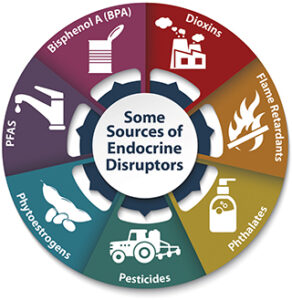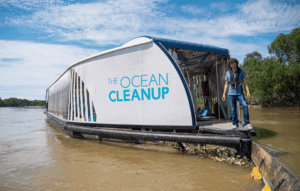When you think about toxins, what comes to mind? The chemicals in your household cleaners? The pesticides sprayed on crops? Sure, those are culprits, but there’s a much more insidious threat lurking in your food, your environment, and maybe even your body right now—and it’s messing with our future in ways we’re only just beginning to understand.
We’re talking about endocrine disruptors, chemicals that interfere with your hormones and could be silently destroying reproductive health across generations. In fact, a 2024 study published in Scientific Reports on these chemicals shows how their damage doesn’t just affect you but could impact your kids and even your grandkids.
It might sound far-fetched—something straight out of a science fiction novel—but it’s very real. And if we don’t start taking this issue seriously, we might face consequences far worse than what we’re seeing today.
Let’s dive into what endocrine disruptors (EDCs) are, how they’re affecting us and our environment, and why their long-term impact could be more devastating than we ever imagined.
What the Heck Are Endocrine Disruptors?
Before we go any further, let’s break down what endocrine disruptors are. Essentially, they’re chemicals that mess with the body’s hormonal system, which is responsible for regulating everything from your metabolism and growth to reproductive health. When these chemicals get into your system, they can mimic hormones, block them, or otherwise mess with the delicate balance that keeps your body functioning properly.
The list of endocrine disruptors is long and scary. Common culprits include:
- Bisphenol A (BPA) – found in plastics, water bottles, and food packaging.
- Phthalates – used in plastics, cosmetics, and personal care products.
- Pesticides – sprayed on crops we eat.
- Phytoestrogens – naturally occurring in soy and certain legumes, often touted as ‘healthy.’

But here’s the kicker: EDCs are everywhere. They’re in the food you eat, the water you drink, and the products you use every single day. And while that might not seem like a big deal, the truth is these chemicals are having profound and long-lasting effects on reproductive health.
A Study That Could Change Everything
Let’s zoom in on one particularly chilling study that looked at a humble insect model—the fruit fly (Drosophila melanogaster)—and the effects of a common dietary endocrine disruptor called equol. Equol is a metabolite of a phytoestrogen found in plants like soy, and it’s something that humans, livestock, and wildlife are constantly consuming.
Now, we’re not fruit flies, but this insect is often used in studies because their biology can reveal similar patterns that might occur in humans over a longer time scale. What did the researchers find? Well, it’s not good.
After exposing fruit flies to equol, the researchers discovered that not only did the initial generation of flies suffer from reduced fertility, but the negative effects persisted across three generations. Even when future generations weren’t directly exposed to equol, their reproductive health was still wrecked. Sperm quality was diminished, DNA was damaged, and fertility rates tanked.
Think about that for a second: These chemicals left a biological scar that didn’t just go away when exposure stopped. In other words, the damage was permanent and could be passed down the family tree.
So, What Does This Mean for Us?
Here’s the million-dollar question: If endocrine disruptors are doing this to fruit flies, what are they doing to us? If you’re like most people, you probably assume that the toxins in your environment might cause a little damage but nothing that will affect you or your kids in a big way.
But what if that’s wrong? What if exposure to common endocrine disruptors like BPA, phthalates, and phytoestrogens is quietly compromising our fertility—not just today but for future generations?
Are We Facing a Fertility Crisis?
Some researchers and health experts think we are. Over the past 40 years, male sperm counts have dropped by more than 50%. And it’s not just men who are affected. Women are seeing a rise in hormonal imbalances, fertility struggles, and complications during pregnancy. It’s like the whole reproductive system is under siege.
You’ve probably heard the argument that infertility is on the rise due to lifestyle factors like stress, poor diet, and waiting longer to have kids. But how much of this crisis can be pinned on the hidden toxins in our environment?
The fruit fly study offers an uncomfortable hint: We’re likely dealing with far more than just lifestyle changes. And the real issue could be that the environmental toxins we’re exposed to today are setting us up for long-term reproductive failure.
The Hidden Role of Agriculture
Let’s get real about where many of these endocrine disruptors come from. A lot of them are linked to agriculture—yes, the very industry that feeds us. Pesticides are often full of endocrine disruptors, and even the crops themselves, like soy, clover, and alfalfa, naturally contain phytoestrogens—compounds that mimic estrogen in the body.
Here’s where things get twisted. For years, we’ve been told that soy and other plant-based foods are good for us. We see soy in everything, from protein powders to baby formula. But what if these so-called ‘healthy’ foods are actually dosing us with low levels of endocrine disruptors?
Even more alarming, livestock and wildlife are eating these crops too, so it’s not just humans who are at risk—entire ecosystems could be suffering. And as the fruit fly study showed, even when organisms stop consuming these toxins, the damage to their reproductive health may have already been passed on.
Endocrine Disruptors and the Decline of Insects
You may have heard about the sharp decline in insect populations over recent years. This isn’t just bad news for bugs—it’s a disaster for ecosystems. Insects play crucial roles in pollination, pest control, and serving as a food source for larger animals. As their populations decline, the ripple effects are felt throughout nature and even in agriculture.
While habitat destruction and climate change are often blamed for insect declines, could endocrine disruptors be the silent killer no one’s talking about? The study on fruit flies suggests that these chemicals might be driving the collapse by impairing reproduction at a genetic level.
If bugs can’t reproduce, they can’t survive. Period. And if endocrine disruptors are causing this much damage to insects, the consequences for biodiversity could be catastrophic.
How Endocrine Disruptors Work Their Magic (Or Rather, Their Curse)
The big danger with endocrine disruptors is that they mimic hormones. In the fruit fly study, equol acted like estrogen, a hormone critical for sexual development and reproduction. By disrupting the natural balance of hormones, equol caused permanent changes in the fruit flies’ reproductive organs and functions.
This is not just happening in insects. In humans, BPA and phthalates, two other common endocrine disruptors, have been shown to lower sperm counts, cause early puberty in girls, and lead to a host of other reproductive issues.
But it gets worse. These chemicals don’t just mess with your hormones temporarily. The damage can be long-lasting and passed down through generations via epigenetic changes—modifications that affect how your genes are expressed without altering the actual DNA sequence. That means your grandkids could be paying the price for the exposure you’re getting right now.
What Can We Do About It?
This is a scary reality, no doubt. But it’s not all doom and gloom. There are steps you can take to protect yourself and your future generations from these hidden dangers. Let’s get practical:
Eat Organic, Whenever Possible: Organic foods are less likely to be grown with synthetic pesticides full of endocrine disruptors. While organic farms might still grow crops like soy that naturally contain phytoestrogens, the overall toxin load is much lower.

AquaTru Countertop Reverse Osmosis Water Purification System Purify Your Water: Tap water can contain a cocktail of EDCs, including BPA and pesticides. A high-quality water purification system can help reduce your exposure.
Choose Better Packaging: Avoid plastic containers whenever possible. Choose glass, stainless steel, or silicone to store food and drinks. Don’t microwave food in plastic containers—it can cause the release of even more toxins into your food.
Be Picky About Personal Care Products: Many cosmetics and personal care items are loaded with endocrine disruptors like phthalates. Opt for products that are EDC-free and use natural ingredients.
Support Sustainable Farming Practices: When you support farms that avoid harmful chemicals, you’re helping to reduce the overall environmental load of endocrine disruptors. This helps both you and the planet.
Get Educated: The more you know about the products you’re using and the food you’re eating, the better choices you can make. Staying informed is one of the most powerful tools you have.
Is It Too Late to Turn the Tide?
It’s easy to feel overwhelmed when you hear about problems like endocrine disruptors. After all, these chemicals are everywhere, and it might seem impossible to avoid them completely. But the truth is, it’s not too late to make a difference.
By making small changes in your daily life—choosing organic foods, filtering your water, and avoiding plastics—you can significantly reduce your exposure to these harmful chemicals. And by raising awareness, you can help push for broader changes in industry and agriculture that reduce the overall presence of EDCs in our environment.
We might not be able to undo the damage that’s already been done, but we can stop adding fuel to the fire. Let’s make sure that future generations aren’t paying the price for our choices today.
Final Thoughts: It’s Time to Take Action
The research is clear: endocrine disruptors are a serious threat to fertility, reproductive health, and even the future of entire species. The study on fruit flies shows just how dangerous these chemicals can be—and it’s time we started paying attention.
The good news? You have the power to protect yourself and your family. By being mindful of the toxins you’re exposed to, making informed choices about the products you use, and supporting sustainable practices, you can help turn the tide.
The question is: Will you?










